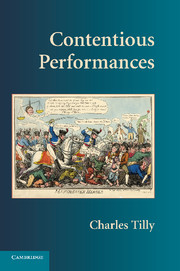Book contents
- Frontmatter
- Contents
- Boxes, Figures, and Tables
- Preface
- Contentious Performances
- 1 CLAIMS AS PERFORMANCES
- 2 HOW TO DETECT AND DESCRIBE PERFORMANCES AND REPERTOIRES
- 3 HOW PERFORMANCES FORM, CHANGE, AND DISAPPEAR
- 4 FROM CAMPAIGN TO CAMPAIGN
- 5 INVENTION OF THE SOCIAL MOVEMENT
- 6 REPERTOIRES AND REGIMES
- 7 CONTENTION IN SPACE AND TIME
- 8 CONCLUSIONS
- References
- Index
7 - CONTENTION IN SPACE AND TIME
Published online by Cambridge University Press: 05 June 2012
- Frontmatter
- Contents
- Boxes, Figures, and Tables
- Preface
- Contentious Performances
- 1 CLAIMS AS PERFORMANCES
- 2 HOW TO DETECT AND DESCRIBE PERFORMANCES AND REPERTOIRES
- 3 HOW PERFORMANCES FORM, CHANGE, AND DISAPPEAR
- 4 FROM CAMPAIGN TO CAMPAIGN
- 5 INVENTION OF THE SOCIAL MOVEMENT
- 6 REPERTOIRES AND REGIMES
- 7 CONTENTION IN SPACE AND TIME
- 8 CONCLUSIONS
- References
- Index
Summary
The United States holds its Labor Day on the first Monday of September. The radical Knights of Labor started the custom in 1882. In a pattern that should now be familiar to this book's readers, the Knights held a parade in New York City on Tuesday (not Monday) 5 September, then repeated the successful performance in September 1884. Meanwhile, supporters of the Knights' rival, International Workingmen's Association (IWA), opted for the 1st of May – May Day – as the occasion on which to display labor's strength across the world and to strike for an eight-hour day. A Chicago coalition of labor unions declared a general strike for May Day 1886. But a vicious, highly visible confrontation between demonstrators and police at a labor rally in Chicago's Haymarket Square on 6 May (known, depending on the observer's political position, as the Haymarket Riot or the Haymarket Massacre) tainted the date.
U.S. president Grover Cleveland feared that May Day would become a memorial to the Haymarket radicals. Pressed by Cleveland, American state legislatures lined up to designate September's first Monday as Labor Day. Thus they implicitly chose the Knights over the IWA. The holiday (now national) has lost its close connection with shows of working-class strength. Many Americans use the weekend as a last chance for a summer getaway, while college and professional football teams start their fall seasons a few days before or after that first Monday.
- Type
- Chapter
- Information
- Contentious Performances , pp. 175 - 199Publisher: Cambridge University PressPrint publication year: 2008

